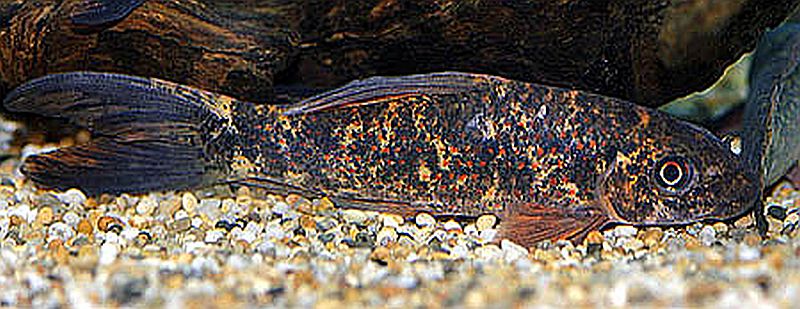The Harlequin Shark (Labeo cyclorhynchus) is native to the middle and lower Congo river basin in the Republic of the Congo, the Democratic Republic of the Congo, and the Ogooué drainage in Gabon, Africa. It is also known to tropical fish keeping enthusiasts as the Harlequin Sharkminnow, or Varigated Shark.
The Harlequin Shark inhabits densely vegetated clear water rain forest streams with thick marginal vegetation. They are usually collected over silt littered substrates in tannin stained waters that are littered with leaves, downed tree branches, and other decomposing organic matter where like other Labeo species, they are primarily aufwuchs feeders that graze along the bottom for microscopic animals, algae, and other detritus.
In their natural habitat, Harlequin Sharks are aggressive loners that lead a solitary lifestyle and except during the spawning season, avoid coming into contact with others of their own kind. They are a highly territorial fish that under no circumstances should be kept with other Labeo or Epalzeorhynchos species, including their own kind. You can expect that most bottom dwelling species such as Bichirs or catfish to be constantly bullied by the Harlequin Shark.
The Harlequin Shark has an unusual gray black mottled body coloration over a creamy yellow base. Their fins are translucent with black mottling and their bodies are shaped like Black Sharks or Rainbow Sharks.
Juvenile Harlequin Sharks have magnificent colors and markings, but their colors fade somewhat as they age. They are notoriously hard to sex, but females are much more thicker bodied than than males, especially when in spawning condition.
Harlequin Sharks are best kept alone or in an African biotope setting with other robust, fast swimming, mid or top water species such as the larger Barbs, Danios, African Characins like Arnoldichthys spilopterus, Brycinus longipinnis, Phenacogrammus or with some of the non African cyprinids. They cannot be kept with others of their own kind, nor with other species that share their same body shape. As juveniles, the Harlequin Shark will spend the majority of their time hiding but as they grow, they become highly territorial and extremely aggressive.
Harlequin Sharks require a well maintained, aged, densely planted, 55 gallon or larger aquarium set up with a silty and round rocky gravel substrate, variably sized rocks and small boulders, some driftwood branches, and plenty of nooks and crannies that can be used for hiding places. Hardy plants such as Bolbitis, Java Fern
, or Anubias can be grown and attached to the rocks or driftwood to promote the growth of algae and biofilm that the fish graze on. Because they are a river dwelling species, the use of a powerhead in the tank is recommended to provide the beneficial current they need.
Because the Harlequin Shark is so intolerant of their own kind and almost impossible to accurately sex, there have been no successful breeding of this egg laying species in an aquarium environment.
In the wild, Harlequin Shark are highly adaptable feeders. Some groups have become specialized towards a particular method of feeding and have been recorded living among groups of hippopotamus, browsing on their bodies. In an aquarium environment, they should be offered regular meals of small live, frozen or freeze dried foods such as mosquito larvae, bloodworms, Daphnia, and brine shrimp along with a good quality flake food, sinking granules, algae wafers, and plenty of vegetable matter. Blanched spinach, shelled peas, cucumber, and finely chopped fruits make good additions to their diet and will promote their colors.
Unfortunately, Harlequin Sharks are not a common item in most tropical fish keeping shops however, from time to time they are available online from importers and specialty shops as juveniles and occasionally adults.
Minimum Tank Size: 55 gallons
Care Level: Moderate
Temperament: Highly Aggressive
Aquarium Hardiness: Hardy
Water Conditions: 72-81°F, dH 3-15°H, pH 6.0-7.5
Max Size: 6″
Color Form: Black, Gray
Diet: Omnivore
Compatibility: Single species tank
Origin: Central Africa
Family: Cyprinidae
Life Span: 4-6 years
Aquarist Experience Level: Intermediate




